Symbolism in Masonic Rings
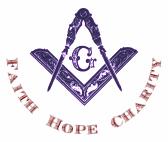
Main | Speaking | Web Resources | Erik's Masonic Journey | Curriculum Vitae
Copyright © 2010-2020 Erik L. Arneson
Strange Claims and Bad Information
There is a surfeit of badly researched, untruthful information on Freemasonry available on the Internet. Sometimes it is located on otherwise excellent websites, and recently I came across an article titled "The Many Hidden Messages in Masonic Rings" by Darren Hoye.1, 2 That article contains a number of strange claims, some of which this article shall address directly, and others which it shall address indirectly by performing its own examination of the symbolism of Masonic rings.
One of the problems with Hoye's article is the lack of attributions. The reader does not know what his sources are when he makes the claim that "Historically speaking, a Freemason could be executed if he allowed his identity to be revealed." One can only assume that he is discussing execution by lynch mobs or government mandate, though this is not made clear. This is a problem that has existed only in certain historical authoritarian regimes such as Nazi Germany, but what has it to do with rings?
Again, later on, he states, "Historically speaking, Masonic rings were meant to be shown only in privacy of a Masonic lodge." But without telling the reader where he learned of this, it is impossible to understand what he is talking about. When and where was it the custom for rings to be worn only in lodge? And if that was the case, then what was the purpose of the rings?
Hoye's understanding of Masonic symbolism is also lacking, as he lists a number of common symbols of the fraternity and either misrepresents or misinterprets them. For example, Euclid's 47th Problem is described as "three squares on some Masonic rings",3 and the Volume of the Sacred Law is described as "open book imagery" that is "symbolic of the quest for knowledge". Though Hoye may occasionally come close to the accepted meaning in some of his descriptions, a quick Google search reveals the imprecision in his hazy definitions.
For those interested in a primer on Masonic symbolism, Bro∴ Allen Robert's The Craft and Its Symbols4 is a great introduction. It is frequently the book recommended to newly-made Freemasons and has been, in fact, part of the introductory package distributed by the Southern California Research Lodge.
The remainder of this article will deal exclusively with the symbols seen on Masonic rings in the United States. Freemasonry is remarkably diverse worldwide, and a comprehensive survey would require a great deal more research.
The Symbols on a Ring
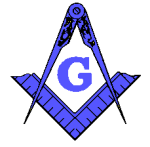 Hoye is correct in stating that there are a large number of symbols
to be seen on Masonic rings. The first three degrees in Freemasonry
are knows as the Blue Lodge and contain an incredible wealth of
symbolism. Among the most common are the square and compasses,
typically the most prominent symbols on a Masonic ring and seen as
representative of the Masonic fraternity as a whole.
Hoye is correct in stating that there are a large number of symbols
to be seen on Masonic rings. The first three degrees in Freemasonry
are knows as the Blue Lodge and contain an incredible wealth of
symbolism. Among the most common are the square and compasses,
typically the most prominent symbols on a Masonic ring and seen as
representative of the Masonic fraternity as a whole.
Most rings featuring the square and compasses will also feature a "G" in their center. However, in modern times it has again become popular to replace the "G" with the All-Seeing Eye (or Eye of Providence). Both of these represent Deity. Some are packed with a large number of additional symbols, sometimes too small to make out. Usually these are taken from the Blue Lodge rituals and will include the plumb, level, beehive, and Volume of the Sacred Law.
Past Master Rings
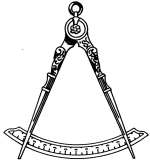 After a Mason has served as the Worshipful Master of his lodge, he
will sometimes wear a ring with one of the various Past Master
symbols. The most common of these are the compasses opened to 60º,
typically with a quadrant replacing the square. Inside the
compasses is usually a depiction of the Sun with a face, or a
mounted precious gem.
After a Mason has served as the Worshipful Master of his lodge, he
will sometimes wear a ring with one of the various Past Master
symbols. The most common of these are the compasses opened to 60º,
typically with a quadrant replacing the square. Inside the
compasses is usually a depiction of the Sun with a face, or a
mounted precious gem.
The compasses, quadrant, and Sun are commonly used as the symbol of a Past Master in most parts of the United States, and can also be found on Masonic aprons, lapel pins, and other items.
Aude, Vide, Tace and Other Latin Mottos
A number of Latin mottos can be found on Masonic rings, several of which are mentioned in Hoye's article. Aude, Vide, Tace means "to hear, to see, to be silent," and is part of an old proverb that originally said, "Listen, see, and be silent if you wish to live in peace."5 It has frequently been confused with similar mottos such as "To know, to dare, to keep silent." In any case, Aude, Vide, Tace reminds a Freemason of his vows of secrecy, and thus makes an excellent inscription for a ring.
In hoc signo vinces is another common Latin motto found on Masonic jewelry, but it is not used in the Blue Lodge. Instead, this motto, which roughly translates as "By this standard, conquer," originally came from the legendary dream of Constantine
- It has been used as a motto by numerous organizations, states,
and schools since then,6 and in a Masonic context, it is typically associated with the highest degrees in York Rite Freemasonry.
Usually accompanied by a double-headed eagle, Spes mea in deo est is a motto used by the 32º of the Scottish Rite, and translates as "My hope is in God."
Finally, Virtus junxit mors non separabit is another Latin motto that will occasionally be found on Masonic rings. Translated as "Whom virtue unites, death shall not separate," it is a motto used in the Lodge of Perfection, which is part of the Scottish Rite.
Other Masonic Symbols
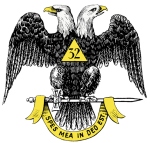 Among the other symbols that may be found on a Masonic ring are
included dozens from appendant bodies. Scimitars and stars from the
Ancient Arabic Order of the Nobles of the Mystic Shrine (known more
commonly as the Shriners), the triple-tau of the Royal Arch Masons,
and the double-headed eagle of the Scottish Rite are frequently
found. In addition, for many years every Scottish Rite Mason
received a ring with the Hebrew letter yod (which looks like a type
of apostrophe) upon reaching the 14º, or Lodge of Perfection. All
of these rings are common.
Among the other symbols that may be found on a Masonic ring are
included dozens from appendant bodies. Scimitars and stars from the
Ancient Arabic Order of the Nobles of the Mystic Shrine (known more
commonly as the Shriners), the triple-tau of the Royal Arch Masons,
and the double-headed eagle of the Scottish Rite are frequently
found. In addition, for many years every Scottish Rite Mason
received a ring with the Hebrew letter yod (which looks like a type
of apostrophe) upon reaching the 14º, or Lodge of Perfection. All
of these rings are common.
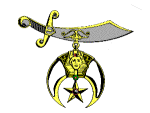 The double-headed eagle is the most common symbol associated with
the Scottish Rite. There are several variations. For instance in
some jurisdictions, the symbol for the 32º has a triangle with the
number 32 on the eagle's breast, while the 33º contains a triangle
with the number 33 above the eagle's heads. Sometimes the shape of
the eagle's heads or wings can indicate the jurisdiction in which
it originated, as well.
The double-headed eagle is the most common symbol associated with
the Scottish Rite. There are several variations. For instance in
some jurisdictions, the symbol for the 32º has a triangle with the
number 32 on the eagle's breast, while the 33º contains a triangle
with the number 33 above the eagle's heads. Sometimes the shape of
the eagle's heads or wings can indicate the jurisdiction in which
it originated, as well.
Conclusion
Examining the symbolism of Masonic rings is not exactly an easy task, but by becoming familiar with the symbolism of Freemasonry, most will become plainly evident. Acquiring such a familiarity is quite simple: most of the symbols in Masonic jewelry are common and well-known to Masons, and have been written about in dozens of books. A trip to the public library might provide a wealth of information, as would a simple phone call to a local Masonic lodge.
This website is a participant in the Amazon Services LLC Associates Program, an affiliate advertising program designed to provide a means to earn fees by linking to Amazon.com and affiliated sites.
Footnotes:
Darren Hoye, "The Many Hidden Messages in Masonic Rings", accessed 14 October, 2010, http://intuitivemeaning.com/2010/06/the-many-hidden-messages-in-masonic-rings/.
Note that as of October of 2011, Hoye's article has been updated to address some of the issues pointed out here. But the Internet remembers everything, so check it out in the Wayback Machine!
Euclid's 47th Problem (or Proposition) is, I suppose, technically three squares. But it would be more proper to describe it as three perfect squares forming a right triangle.
Allen E. Roberts, The Craft and Its Symbols (Macoy Publishing and Masonic Supply Company, 1974).
Accessed 14 October, 2010, http://www.daltai.com/proverbs/weeks/week120.htm.
Accessed 14 October, 2010, http://en.wikipedia.org/wiki/In_hoc_signo_vinces.